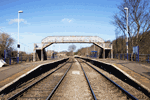The railway from Sheffield to Cleethorpes is one of those routes that seem to have been by-passed by the 20 years of investment and progress on our railways seen elsewhere.
Gainsborough, in particular, despite having two stations (Lea Road and Central), is suffering the gross indignities of underinvestment that would make even the penny pinchers of 1960s British Railways wince. This is an example of a railway that is anything but joined up. It’s disjointed, very poorly configured and (in numerous places) quite literally falling apart.
Through the early and mid-20th century, the line from Sheffield to Cleethorpes via Gainsborough was a main line. It allowed the working populations of the cities of Lincoln and Sheffield to reach the seaside at Cleethorpes, and boasted a major freight-carrying capability, supported by goods yards and facilities along the route.
The major station on the line is - or rather was - Gainsborough Central, which is a virtually derelict shadow of its former glory. The town has had a railway since 1849.
Today, Gainsborough seems at first glance to be nothing more than a medium-sized Lincolnshire town with perhaps fewer amenities than it deserves. Further investigation, however, illustrates some of the problems that the railways have faced for decades and which have yet to be solved here. All of these have been made worse by poor alignment of the privatised structure, leading to the shabby facilities endured by passengers today.
Gainsborough was once a major manufacturing centre in the East of England. It had the Marshalls works producing steam engines and tractors, which were exported globally. It even had a sweet wrapper factory that also made seaside rock! The town still has a population of more than 20,000 for its two railway stations, a nearby power station at West Burton and a sizeable steel working, industrial and manufacturing centre just outside the town.
Yet the service on the line through Gainsborough Central to Cleethorpes now numbers just three trains a week, operated on Saturdays-only since 1993. There are no weekday services on the Central line. Operator Northern Rail is clear that there are no plans to increase services. Worryingly, the Invitation To Tender (ITT) for the next franchise does not require an improvement of the Brigg line’s parlous service.
Northern Managing Director Alex Hynes made clear on local radio earlier this year that Northern was concentrating on its peak commuter services, not branch lines. He could give locals no hope that their stations and railway would be satisfactorily upgraded before the end of the current franchise.
However, the Friends of the Brigg and Lincoln Line (FoBLL), the local campaign group founded in 2012 and run with tremendous enthusiasm by Paul Johnson, is not willing to accept this. And it is fighting back.
The group campaigns tirelessly to improve stations and services on the route. Its main aims are currently to increase service frequency to Cleethorpes and to clean up and improve both woefully badly-maintained stations serving Gainsborough and its nearby towns and villages. Currently, it is these local, self-financed volunteers (not the TOCs) who are driving very limited improvements and getting most of the work done.
Gainsborough Central is managed by Northern and in 2014 was labelled Britain’s worst railway station by railway observer Andrew Dowd, writing in The Times. You can see why within minutes of arriving.
Until 1977, the station had a fine building (designed by Hadfield & Weightman of Sheffield, for the Manchester Sheffield & Lincolnshire Railway), an overall trainshed roof and a colonnaded porte cochère fronting onto the road that gave it a classic appearance matched by others on the line. There was also a considerable goods yard, locomotive shed and a fully staffed booking office with refreshment and waiting facilities.
But to go there now is to visit a sadly underused and under-funded derelict relic of immediate post-privatisation, post-industrial Britain. The platforms are weed-ridden, the boundary walls are crumbling, the fine Victorian lattice footbridge (the only surviving passenger infrastructure on the platforms) is peeling and deeply rusted, and even the platform destination signs were only installed this year - which is appalling, even for a station as little used as this.
The signs were finally installed after FoBLL brought to Northern’s attention that local volunteers had produced hand-drawn signage for the platform. The railway had provided absolutely nothing. There are no real-time train information boards, no announcement systems, and barely even a roof on the flimsy, metal-framed shelter. If you didn’t see it, you’d be reluctant to believe it.
But there is little use bemoaning the loss of our heritage railway buildings - they are long gone, along with the frequent weekday services once enjoyed by the station’s passengers.
What can be done - and is being done - in the face of appalling neglect by the privatised railway is activism to improve what little is left. FoBLL has been campaigning successfully for improved signage. The neighbouring (superb and busy) shopping centre will soon boast British Railways-style enamel signage for the station. And it is hoped that a meeting held on June 19 between locals, train operators and Network Rail will yield positive results. We shall report back!
















Comment as guest
Comments
chris - 16/11/2015 12:47
Great article about time network rail are shown for what they really are -notwork rail Gainsborough central is a disgrace
Reply as guest